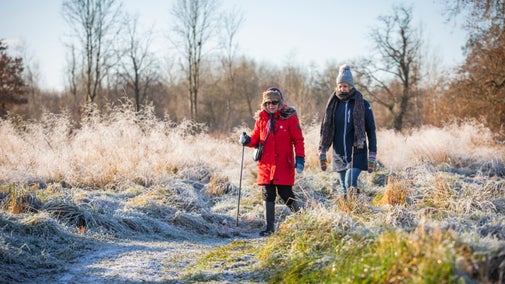Horsey Windpump and beach walk
Norfolk
Experience the Horsey Broadland landscape on this walk to the beach and back, following grassy paths and tracks, encompassing low-lying grazing marshes, sand dunes and a narrow sandy beach, with the chance of seeing grey seals.
Near to
Horsey WindpumpStart point
National Trust Car Park, Horsey Windpump: TG456223Trail information
*Marshes can become muddy and wet outside summer months. Please give seals a wide berth and follow any signs on the site. For further details, please see section marked Terrain.
***Dogs welcome but keep on leads or close control, especially when crossing fields with livestock. For further details, please see section marked Facilities.
Weather warning
During wet weather and the colder months, paths around Horsey can become waterlogged, muddy and slippery underfoot. Please take care.
More near here
Horsey Beach and village circular walk
This circular walk takes you through the Norfolk Coast Area of Outstanding Natural Beauty as well as The Broads National Park, passing by the seal colony at Horsey Beach.

Horsey Windpump and Estate walk
Follow the Horsey Windpump and Estate Walk to discover the Broadland landscape including Horsey Mere and wildlife in Norfolk.

Get in touch
Our partners

We’ve partnered with Cotswold Outdoor to help everyone make the most of their time outdoors in the places we care for.
You might also be interested in
Walking
Explore some of the finest landscapes in our care on coastal paths, accessible trails, woodland walks and everything in between. Find the best places to walk near you.

Cotswold Outdoor: our exclusive walking partner
Learn about the National Trust’s ongoing partnership with Cotswold Outdoor. Find out how they help us care for precious places and the exclusive discount available for National Trust supporters.

Staying safe at National Trust places
The special places in National Trust care sometimes come with a few risks for visitors, be it coastline or countryside. Find out how to keep safe throughout your visits.

Follow the Countryside Code
Help to look after National Trust places by observing a few simple guidelines during your visit and following the Countryside Code.

Things to do at Horsey Windpump
Enjoy the spectacular views from the top of Horsey Windpump, with special sights from the windows on all five floors on the way to the top, with 61 steps in total.

Eating and shopping at Horsey Windpump
The café serves a range of hot and cold drinks and snacks. Stop by the second-hand bookshop and bag yourself a new read.

Outdoor activities
Searching for a new outdoor activity to try? Discover the best places in our care for outdoor activities, including off-road cycle tracks, walking trails and coastlines for watersports.

Walking in Norfolk
Discover the best walks around Norfolk, from a stroll around the estate at Blickling to a bracing trek on the Norfolk Coast Path.


